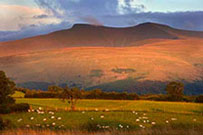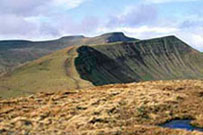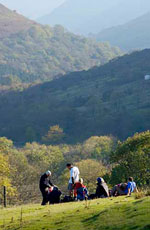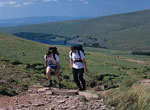The Brecon Beacons National Park
Activity and Research 2
2. Key information about the Brecon Beacons National Park
- Covers 1347 square kilometres.
- The main towns are Brecon, Crickhowell and Hay-on-Wye
- About 33,000 people live within the national park.
- The park is on the edge of the South Wales coalfield and the highest point is Pen-y-Fan at 886 metres
- The landscape is varied and consists of glaciated valleys peat bogs and heather moorlands as well as cave systems, rivers and waterfalls.
- The human landscape includes ancient hill forts, castles and churches.
- The present day settlement consists of scattered towns and villages and hill farms.
- There are about 3.4 million day visits to the park.
- About 250,000 people stay for at least one night in the park.
- About 2,900 people are employed directly or indirectly related to tourism in the national park.
- Each day visitor spends about £22 on average, each staying visitor spends about £90
Visitors to the Brecon Beacons National Park
Like in all National Parks, most visitors to the Brecon Beacons arrive by car. Everybody living in South Wales, Birmingham and the West Midlands are within a two-hour drive of the park, as well as those living in Bristol and Bath.
Visitors to the Brecon Beacons can be put into three groups.
- Day visitors. These are people who live in the area around the park including Cardiff, Birmingham and other large towns, who visit the park for the day, take part in some leisure or recreational activity are return home.
- Tourists who are staying within the Park boundary. These people will be on holiday or staying for some other tourist purpose such as a business or educational visit.
- Tourists who are not staying within the Park but are visiting the Park as part of a holiday or some other tourist activity.
These groups have different impacts on the environment and economy of the Brecon Beacons.
People who visit for the day will tend to travel by car causing pollution and will need somewhere to park their cars when they arrive. If car parks are not provided they will tend to park on kerbs and verges causing damage to the landscape. Also, if they arrive or leave at the same time, which is possible, they will cause congestion. At the same time, people travelling for the day may contribute very little to the economy of the Park. They may not pay to enter attractions and may not buy food and other products from the local community.
People who stay in the Park will generally contribute more to the local economy. They will stay in accommodation owned by local people, buy food and other products from local businesses and will be more likely to visit attractions. They will also interact more with the community and learn more about the local culture and environment.
One of the challenges facing the National Park Authority is how to turn day visitors into staying visitors so that they contribute more to the economy of the Brecon Beacons.
- Find out basic facts about one other National Park, such as the Pembrokeshire Coast or Snowdonia and compare it with the Brecon Beacons.
- Produce a PowerPoint presentation introducing the Brecon Beacons National Park.
- Use a route planner to find out how to get to Brecon from where you live.
- Explain why having more staying visitors will help the economy of the Brecon Beacons National Park.




